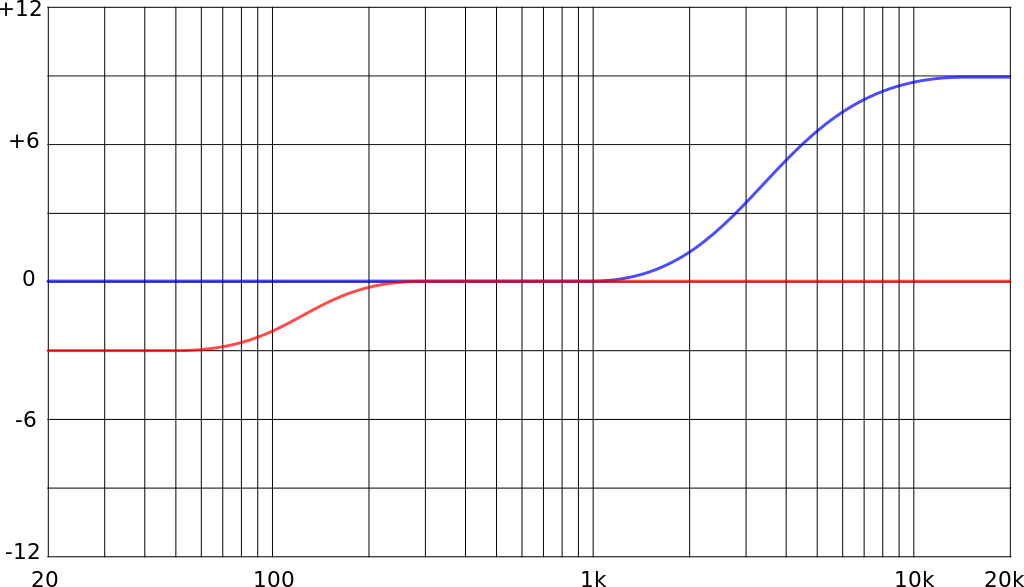https://blog.csdn.net/qiumingjian/article/details/46326269
https://blog.csdn.net/sszhouplus/article/details/43115769
https://en.wikipedia.org/wiki/Equalization_(audio)#Shelving_filter
一. 声学背景
心理声学研究证实人耳可闻的声音频率范围为20Hz--20kHz。在可闻的频率范围内,不同的频段对人耳的感知影响不同。
如下所述:
1. 20Hz--60Hz部分
这一段提升能给音乐强有力的感觉,给人很响的感觉,如雷声。是音乐中强劲有力的感觉。如果提升过高,则又会混浊不清,造成清晰度不佳,特别是低频响应差和低频过重的音响设备。
2. 60Hz--250Hz部分
这段是音乐的低频结构,它们包含了节奏部分的基础音,包括基音、节奏音的主音。它和高中音的比例构成了音色结构的平衡特性。提升这一段可使声音丰满,过度提升会发出隆隆声。衰减这两段会使声音单薄。
3. 250Hz--2KHz部分
这段包含了大多数乐器的低频谐波,如果提升过多会使声音像电话里的声音。如把600Hz和1kHz过度提升会使声音像喇叭的声音。如把3kHz提升过多会掩蔽说话的识别音,即口齿不清,并使唇音“mbv”难以分辨。如把1kHz和3kHz过分提升会使声音具有金属感。由于人耳对这一频段比较敏感,通常不调节这一段,过分提升这一段会使听觉疲劳。
4. 2KHz--4kHz部分
这段频率属中频,如果提升得过高会掩盖说话的识别音,尤其是3kHz提升过高,会引起听觉疲劳。
5. 4kHz--5KHz部分
这是具有临场感的频段,它影响语言和乐器等声音的清晰度。提升这一频段,使人感觉声源与听者的距离显得稍近了一些;衰减5kHz,就会使声音的距离感变远;如果在5kHz左右提出升6dB,则会使整个混合声音的声功率提升3dB。
6. 6kHz--16kHz部分
这一频段控制着音色的明亮度,宏亮度和清晰度。一般来说提升这几段使声音宏亮,但不清晰,不可能会引起齿音过重,衰减时声音变得清晰,但声音不宏亮。”
二. 数字信号处理原理
从声学原理出发,Equalizer的物理意义在于通过对频域进行频带划分(根据个人需要,通常为5,10,12,15个子带)并对不同的频带施加相应的增益,从而改变原始数据频域能量分布,达到改变主观听感的作用(常用的低音增强bassboost效果也可通过该方式实现)。常用的Equalizer分类包含Pop(流行乐), Jazz(爵士), HeavyMetal(重金属),Electronic(电音),Classic(古典)等等
设滤波系统传递函数H(z),原始音频通过滤波系统,输出Y(z) = X(z)*H(z)。考虑到频带的划分及频带滤波增益。最终的信号输出

其中BandCount表示划分的子带个数;系数a表示对应频带的增益;H(w)为对用频段的带通滤波器传递函数。
滤波系统H(z)的常规表示为:

转换到时域系统单位冲击响应表示为:

3. EQ filter
Peak filter是常用在音频数字均衡器中的一种滤波器.
Peak filter的主要参数为:
Fo:center frequecy.
G: gain (db) at center frequency.
Q:quality factor.
BW=Fo/Q.Q越大,BW越小,滤波器频率响应越sharp.
下图的Peak filter在100Hz cut 6db,在1KHz处boost 9db.

shelve filter也可用在EQ中用来调节bass和treble部分的gain
如下图的shelve filter 在bass部分cut 3db,在treble部分boost 9db.

4.PEQ & GEQ
GEQ划分的频段数目是固定的,用户可以调节每个频段的gain值。
PEQ用户可以EQ filter的任意参数,包括调节中心频率,gain值,Band width(Q).
Graphic equalizer
In the
graphic equalizer, the input signal is sent to a bank of
filters. Each filter passes the portion of the signal present in its own frequency range or
band. The amplitude passed by each filter is adjusted using a slide control to boost or cut frequency components passed by that filter. The vertical position of each slider thus indicates the gain applied at that frequency band, so that the knobs resemble a
graph of the equalizer's response plotted versus frequency.
The number of frequency channels (and therefore each one's bandwidth) affects the cost of production and may be matched to the requirements of the intended application. A
car audio equalizer might have one set of controls applying the same gain to both stereo channels for convenience, with a total of five to ten frequency bands. On the other hand, an equalizer for professional
live sound reinforcement typically has some 25 to 31 bands, for more precise control of feedback problems and equalization of
room modes. Such an equalizer (as shown above) is called a 1/3-octave equalizer (spoken informally as "
third-octave EQ") because the center frequency of its filters are spaced one third of an
octave apart, three filters to an octave. Equalizers with half as many filters per octave are common where less precise control is required—this design is called a 2/3-octave equalizer.

UREI graphic and parametric EQs
Parametric equalizer
Parametric equalizers are multi-band variable equalizers which allow users to control the three primary parameters:
amplitude,
center frequency and
bandwidth. The amplitude of each band can be controlled, and the center frequency can be shifted, and bandwidth (which is inversely related to "
Q") can be widened or narrowed. Parametric equalizers are capable of making much more precise adjustments to sound than other equalizers, and are commonly used in sound recording and
live sound reinforcement. Parametric equalizers are also sold as standalone
outboard gear units.
A variant of the parametric equalizer is the semi-parametric equalizer, also known as a sweepable filter. It allows users to control the amplitude and frequency, but uses a pre-set bandwidth of the center frequency. In some cases, semi-parametric equalizers allow the user to select between a wide and a narrow preset bandwidth.

The equaliser section from the
Audient ASP8024 Mixing console. The upper section has high and low shelving EQ, the lower section has fully parametric EQ.






